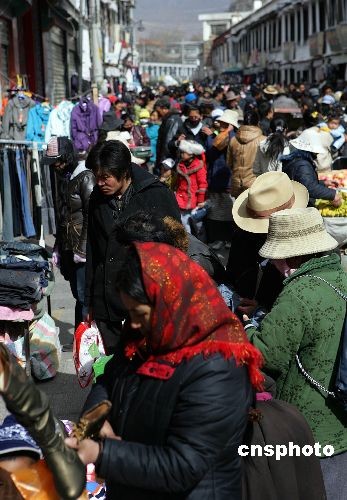Perched atop a craggy hill that dominates Lhasa's skyline, the red-and-white structures of the Potala Palace are packed with pilgrims Wednesday, the eighth day of the Tibetan new year.

Still a day to go before the spring semester opens at most Tibetan schools, children are frequently seen in the crowd, running briskly along the hilly, zigzagging path to hilltop and holding petty amounts of cash as offerings.
Even babies do not cry at the sight of the hustling crowd and the wrathful looks of the "guardians of Buddhism" seen everywhere in the halls. They stare curiously from behind their parents' back at the gold, silver and bronze statues and frescoes.
One baby, about six months old, opened his own hand as his mother bowed, added yak butter to the sacred lamp, offered a petty offering and presented a hada to the former Dalai Lamas' throne by throwing the white scarf over the fence about 10 meters away.
Many babies have their noses dubbed black with ashes, a mark that is widely believed to scare away evil.
"The child doesn't sleep well at night," said Pempa Tsering from Xigaze. His son, Kelsang Puncog, is about 17 months old. "We hope he'll sleep better and become stronger after this pilgrimage."
A Tibet University graduate, Pempa Tsering speaks fluent Tibetan, Mandarin and English and is one of the 500 English-speaking tour guides in the plateau region. "I take tourists to Mt. Qomolangma (Everest) about 50 times a year," he said.
Despite his proficiency in English and constant exposure to Western culture, Pempa Tsering does not hesitate to kneel down and pray for his family's happiness and health. "This is what I like most about Tibet: I can keep to my faith while earning a decent living."
Though he refuses to reveal his earnings as a tour guide, Pempa Tsering confirms he makes enough money to spare his wife from having to work. He is also in the market for a van so that he won't have to rent vehicles from travel services when the tourist rush starts again in April. "I might buy a nine-seater Chinese Jinbei, for about 160,000 yuan ($23,500)."
Officials with the Potala Palace administration kept watch, stopping tourists from snapping photos inside the halls, or diverting the crowd in time to prevent a potential stampede as most pilgrims walk in haste and are occasionally in danger of stumbling on the slippery, steepy staircases.
A year after mobs set fire to shops and attacked innocent civilians in the holy city of Lhasa, policemen and soldiers of the People's Liberation Army (PLA) have tightened security here. Officers and soldiers are patrolling downtown Lhasa streets and near major religious sites, some armed with guns. The pilgrims paid them little attention.
"What are you shooting?" a policeman came up and curiously asked as Xinhua reporters snapped photos of the pilgrims outside the Potala Palace. He beamed when we showed him the photos and wished us a pleasant journey.
NEW YEAR PRAYERS
Thousands of Buddhists gathered in monasteries and nunneries in Lhasa Wednesday to give alms and pray at the annual Buddhist service of Moinlam Quenmo, or "summons ceremony" that begins on the eighth day of the Tibetan new year and lasts for a week.
More than 2,000 pilgrims, holding prayer wheels and kettles of yak butter, arrived at the Drepung Monastery, one of the major temples in Lhasa, before a Sutra debate started at 11 a.m. in an open space outside the hillside temple.
Chosphel Rigzin and Chosphel Bandain, two 20-something candidates for a junior degree in Buddhist studies, sat in front of about 100 lamas for a Sutra debate before the summons ceremony. The lamas took turns clapping hands and asking questions, which the two candidates answered quoting the Sutra or using its logic - and got booed by the crowd when they got it wrong.
The lamas, aged from 18 on, study the sutra from 6 a.m. to midnight and hold Sutra debate several times a day. Most of them need to study 20 to 30 years before they pass the formal dissertation for Geshe Lharampa, the highest academic degree for the Gelugba School - also known as the Yellow Sect - of Tibetan Buddhism, said Doje Tsering, an official and Tibetan studies specialist with the regional government's committee in charge of religious affairs.
After the debate, the lamas sat in the main hall of the temple to pray for the pilgrims, who poured into the temple in long queues, bowed or kowtowed and offered alms.

The names of the donors were then chanted, in Tibetan language, and the ceremony continued until the crowd of pilgrims left.
The ceremony was initiated in 1409 by Tsong Ka-pa, founder of the yellow sect of the Tibetan Lamaism.
"I come here every year," said 40-year-old Yeshe Drolma, a pilgrim from the suburbs of Lhasa holding a prayer wheel in one hand and a stack of new one-yuan banknotes in the other. "As usual, I pray for the health and good luck of all the family."
The regional government also offered a meal, tea and a 30-yuan subsidy to each lama.
Tibet has more than 1,700 religious sites, accommodating 46,000 monks and nuns that make up about two percent of the region's population.
"Buddhism has always been an inseparable part of the Tibetans' life," said Minyag Kungze, abbot of Mindroling Monastery in Shannan Prefecture. "At least 90 percent of the Tibetans are Buddhists. That's good for social stability, because peace, harmony and benevolence are the basic teachings of Buddhism."
(China Daily March 5, 2009)